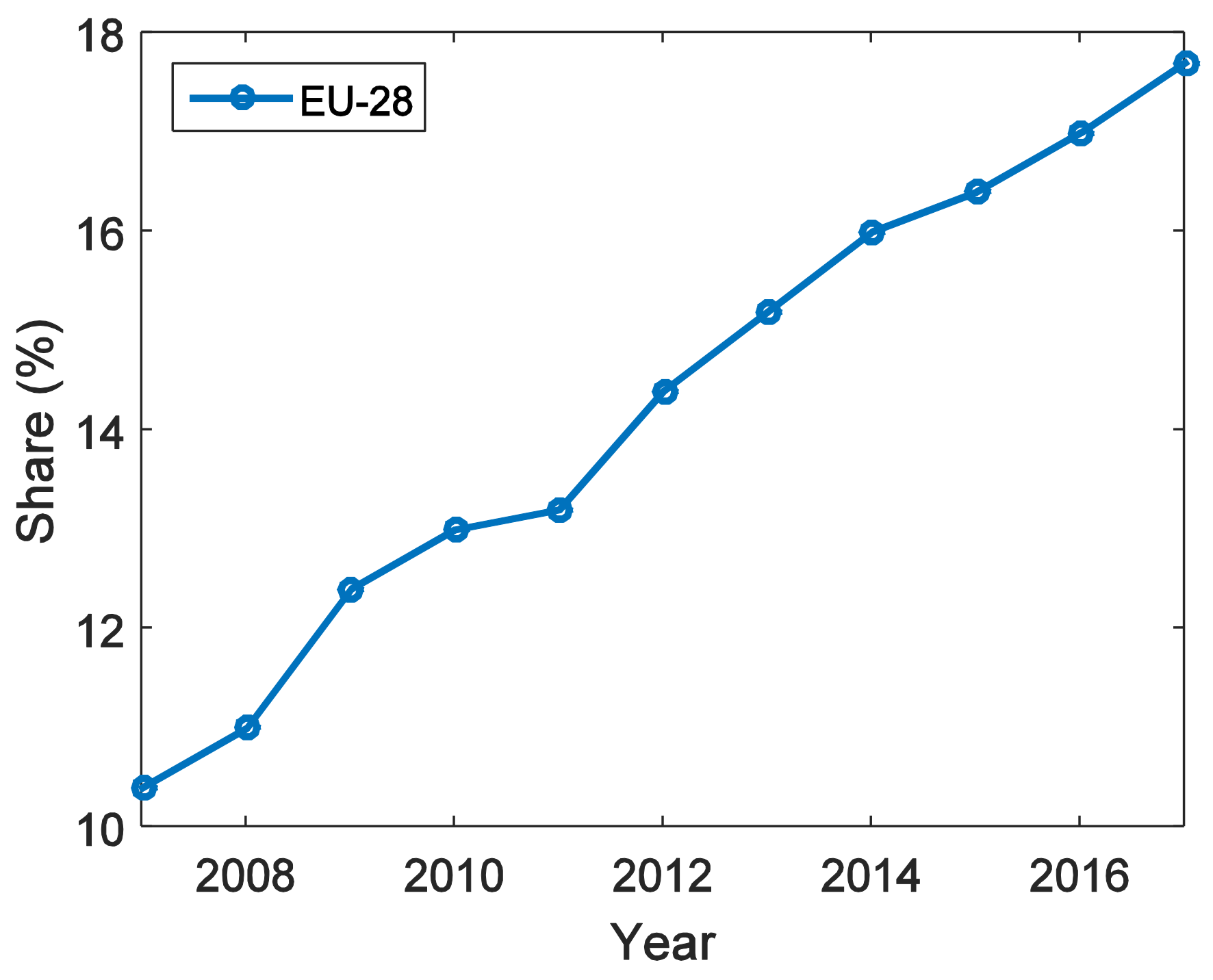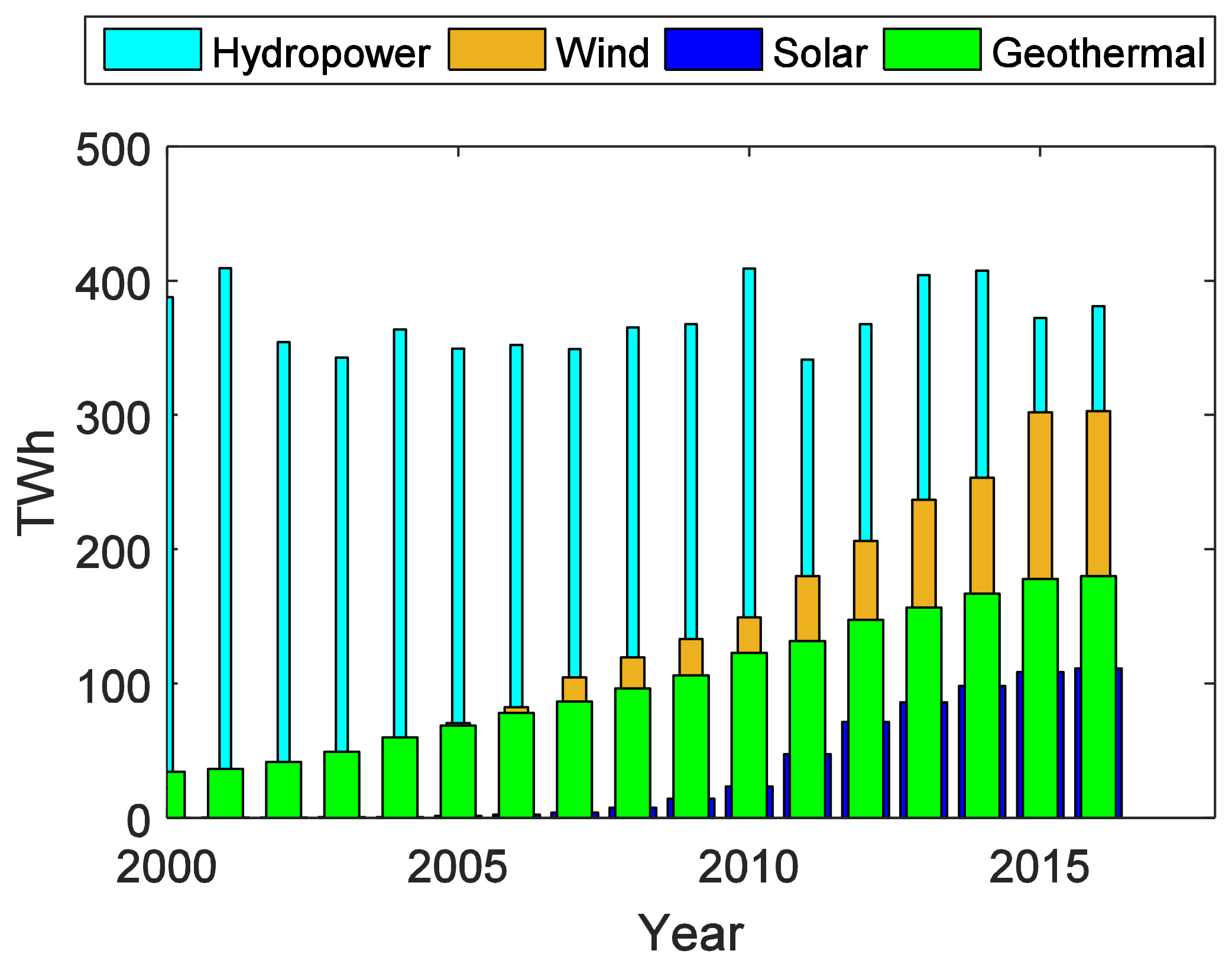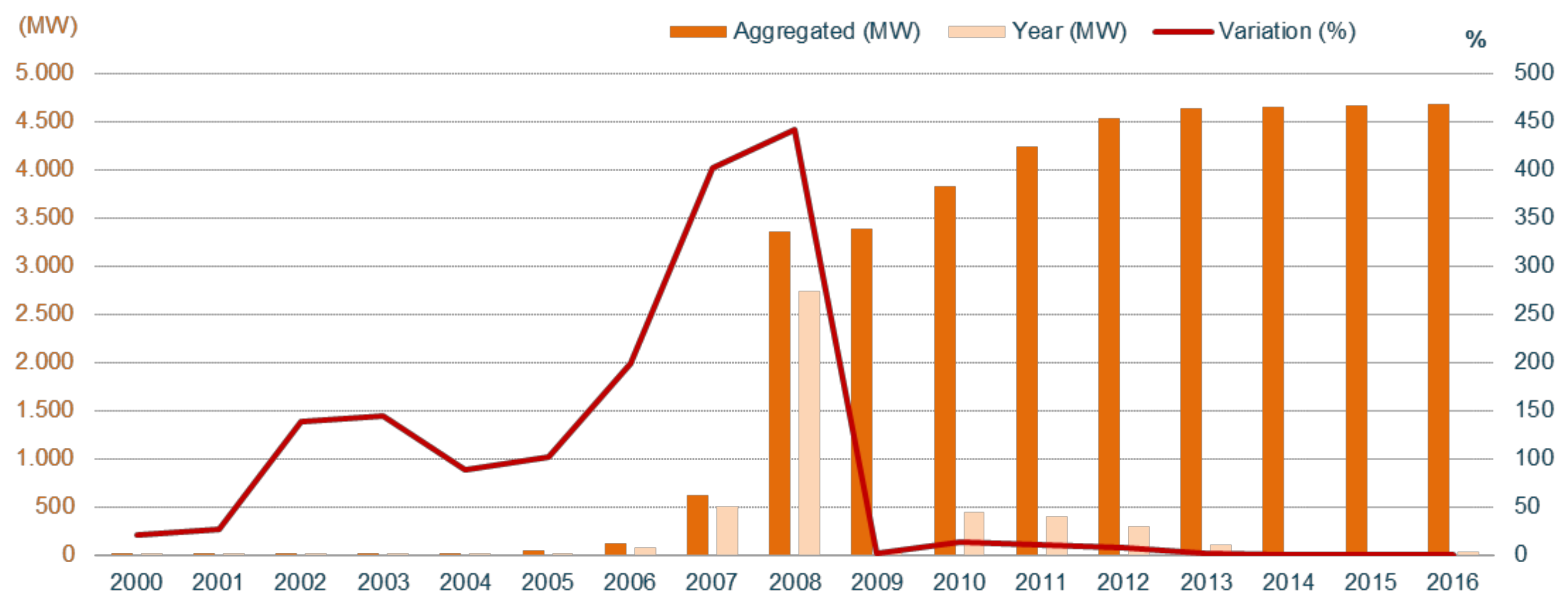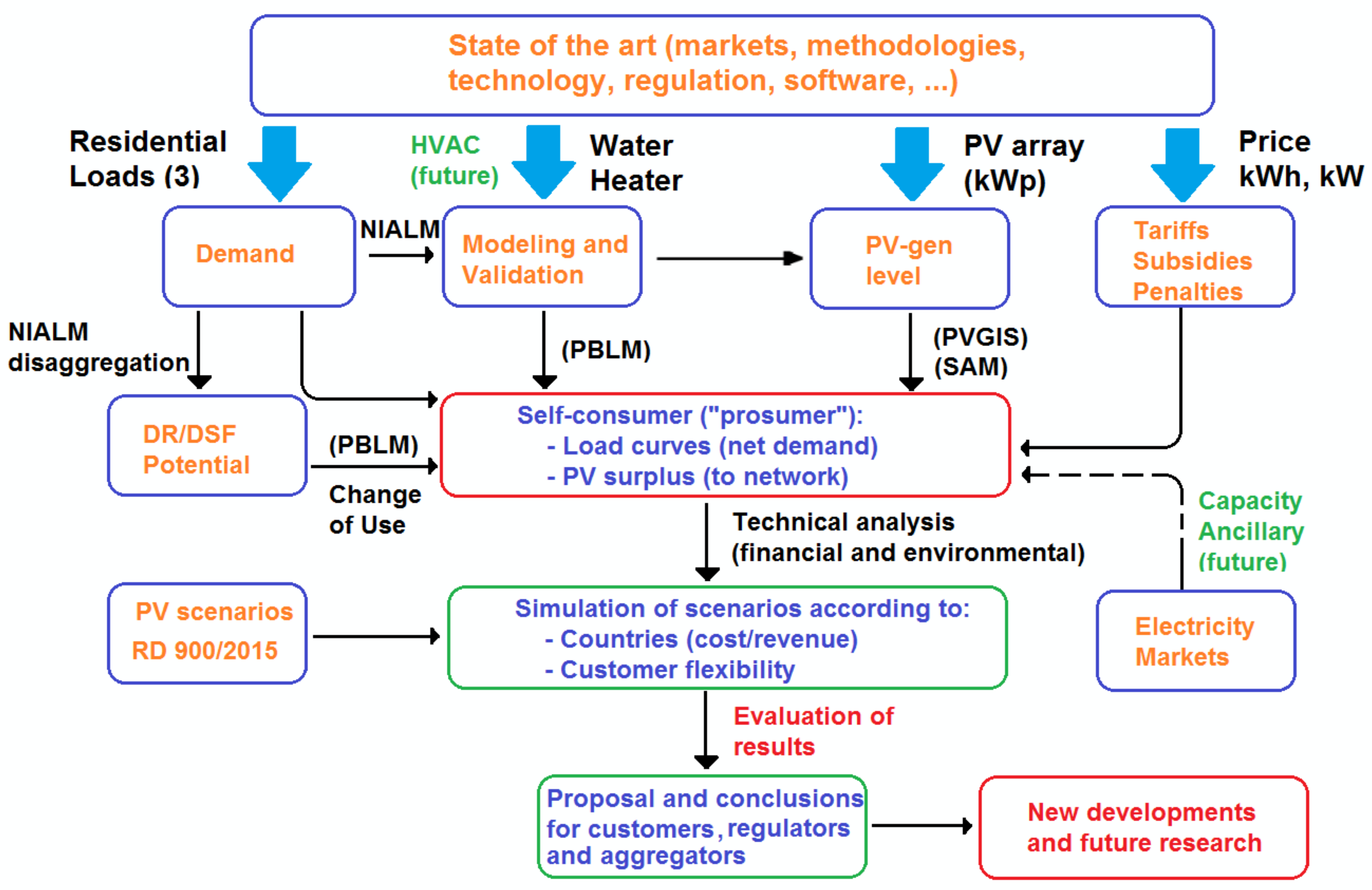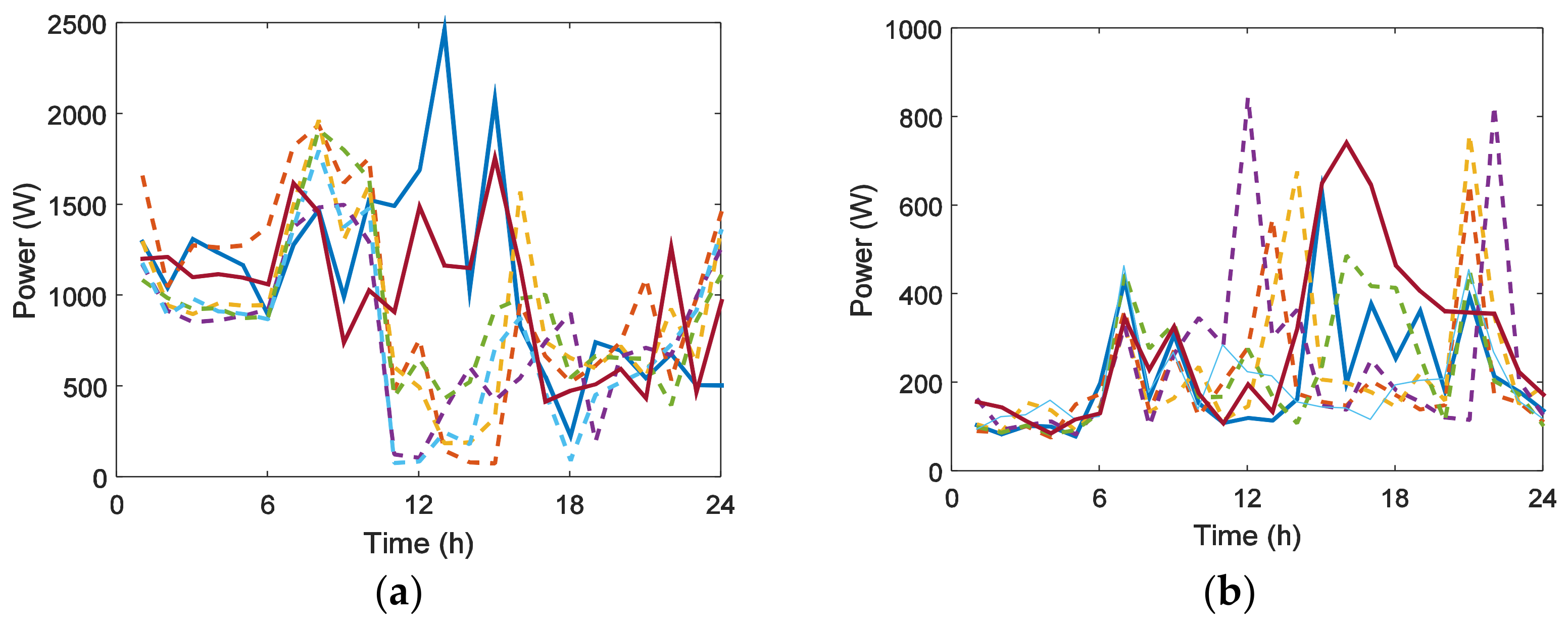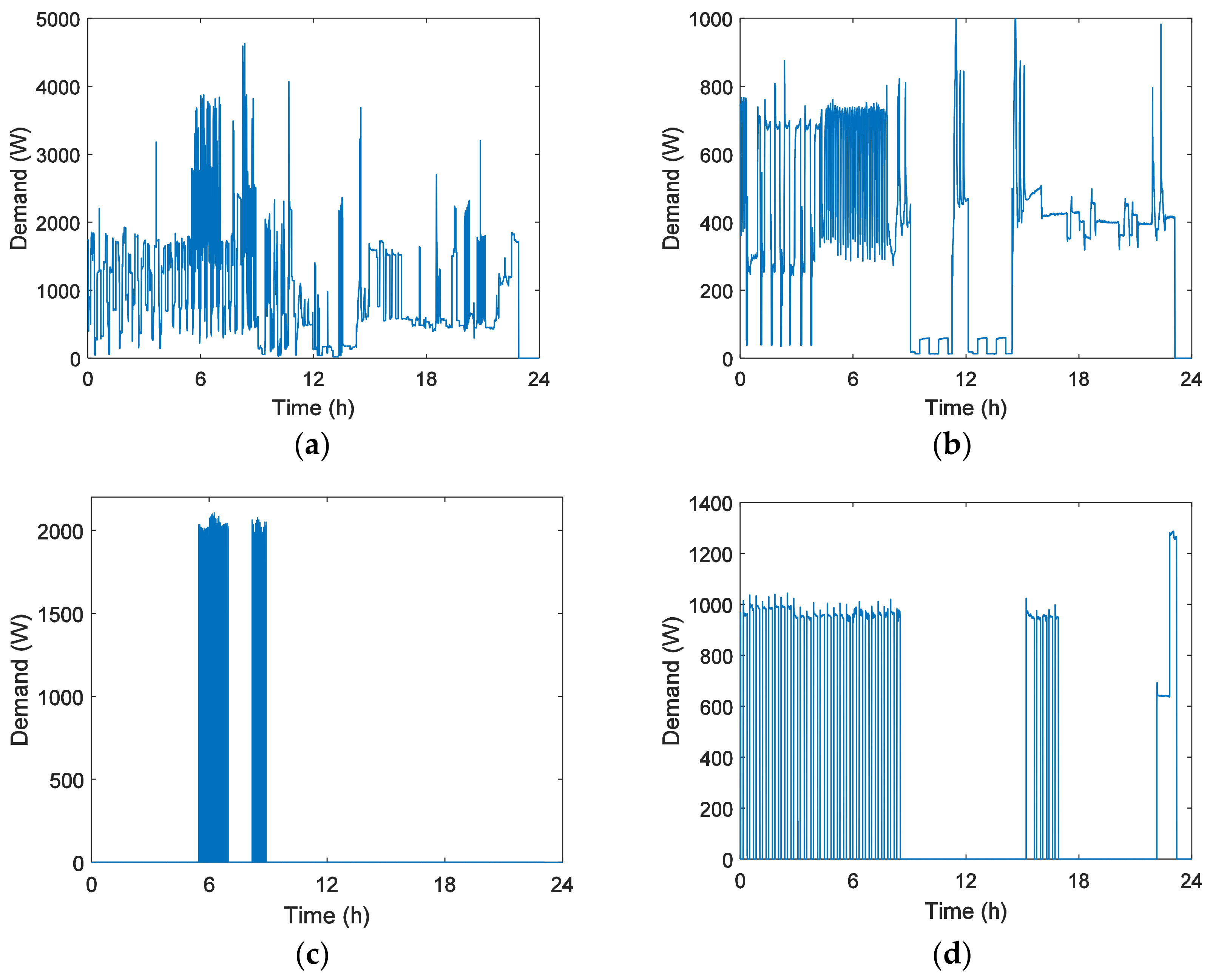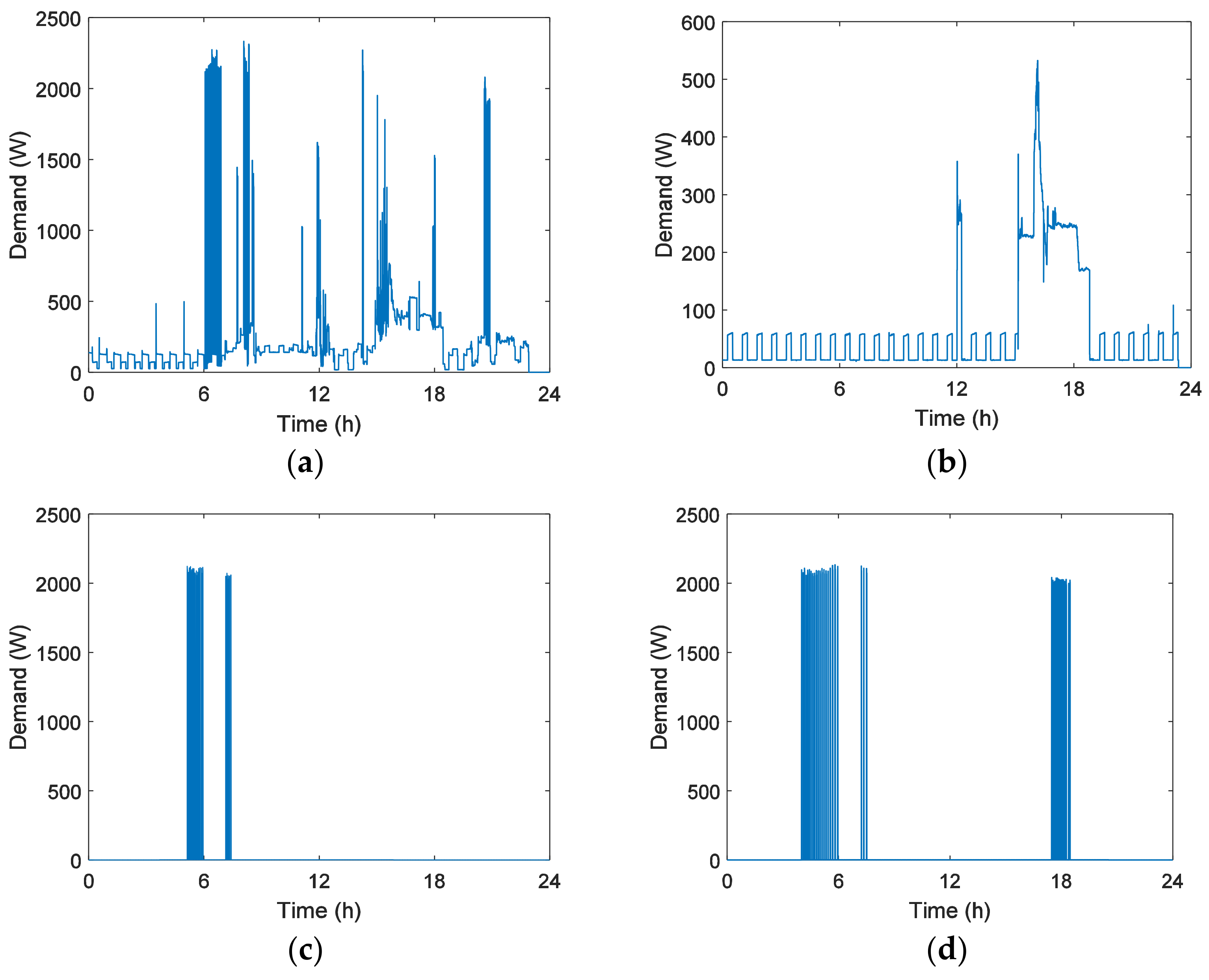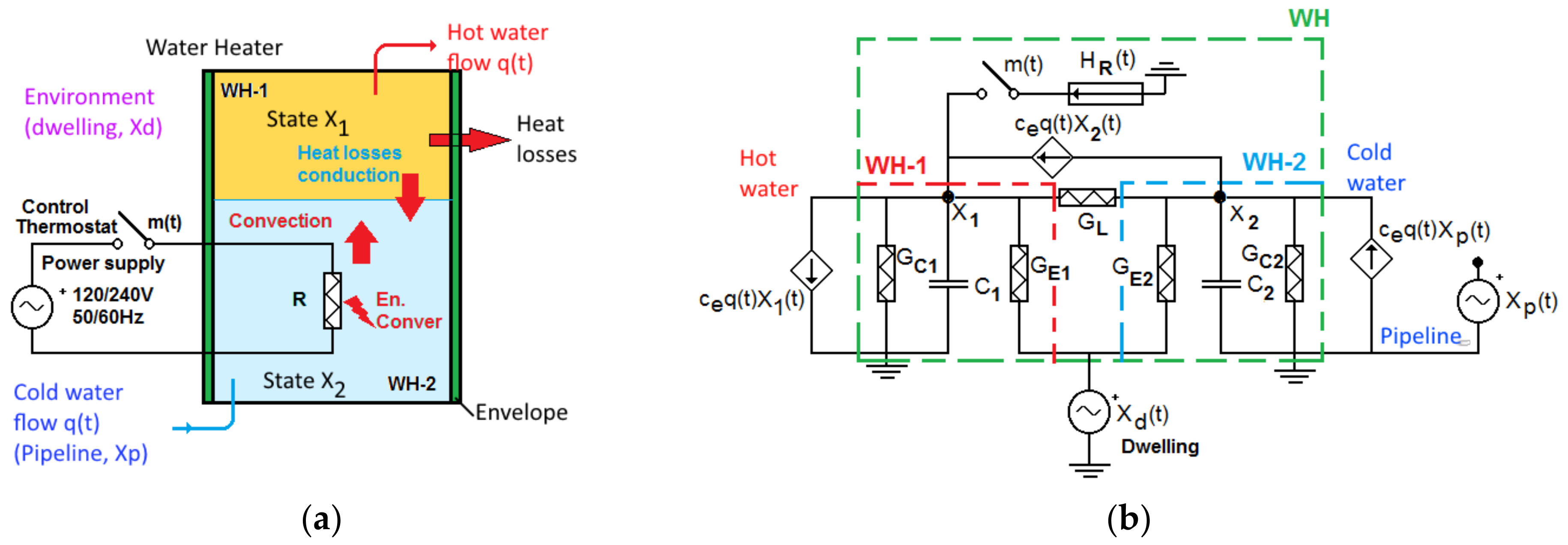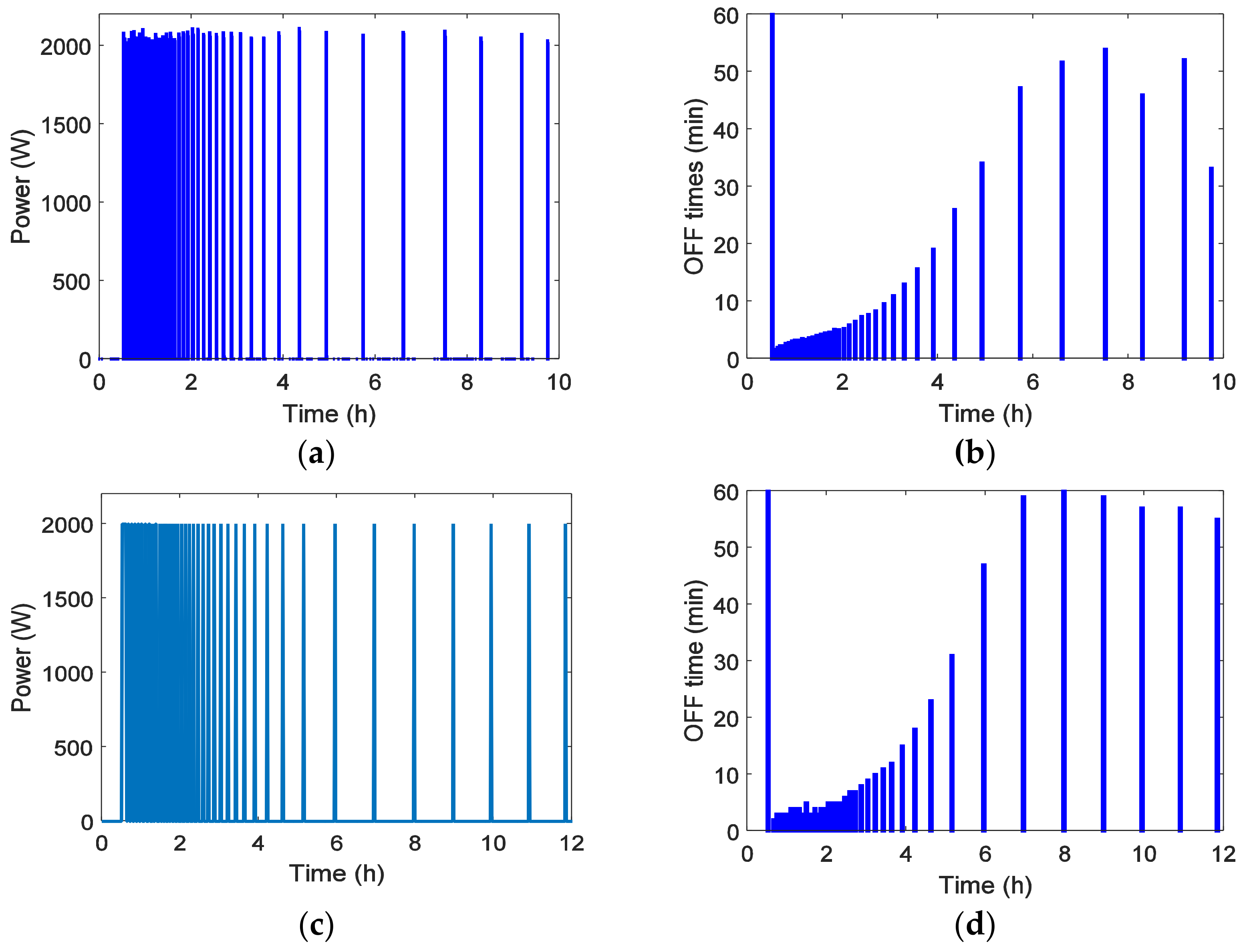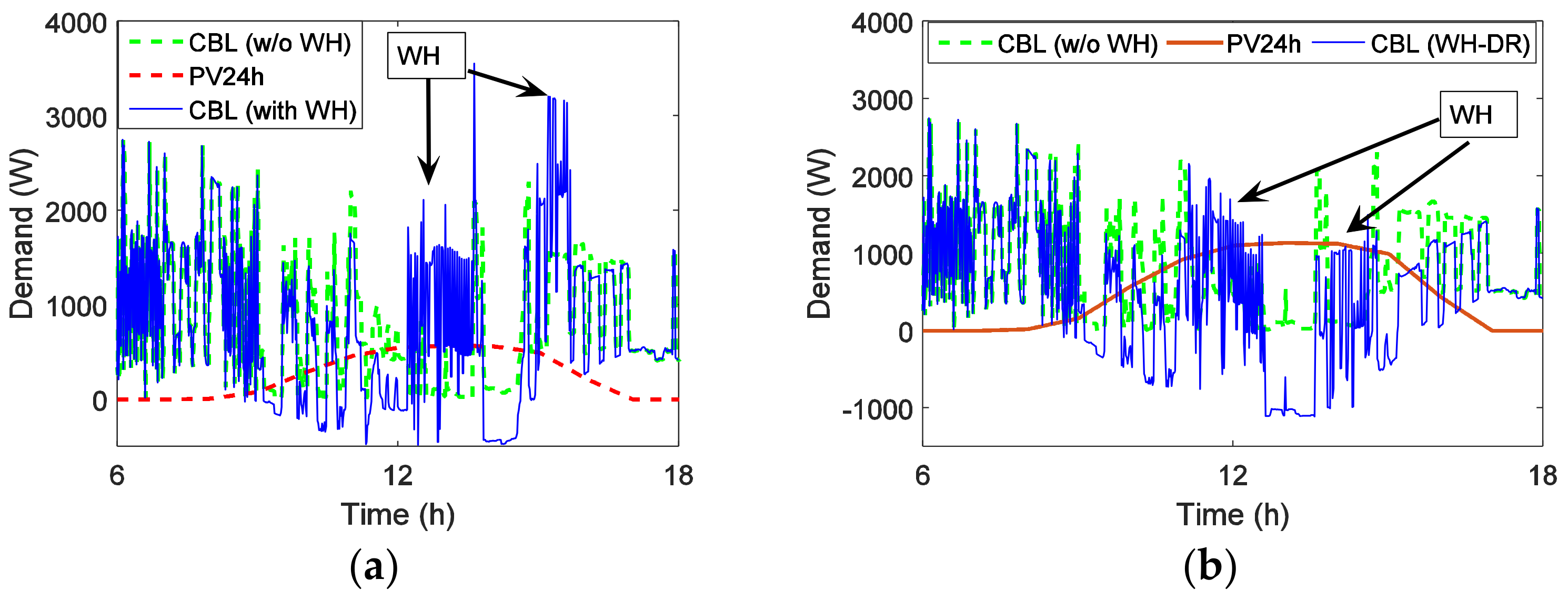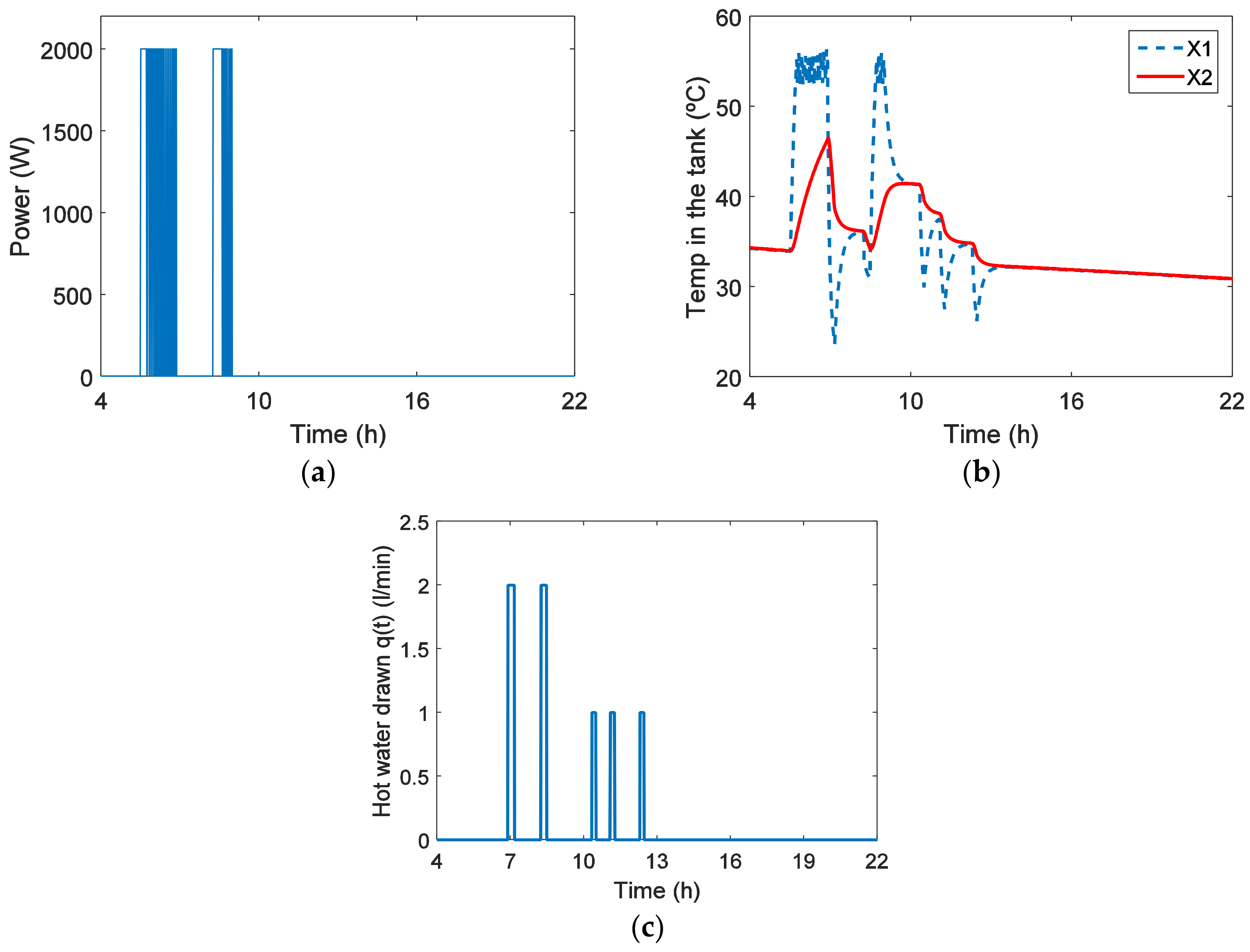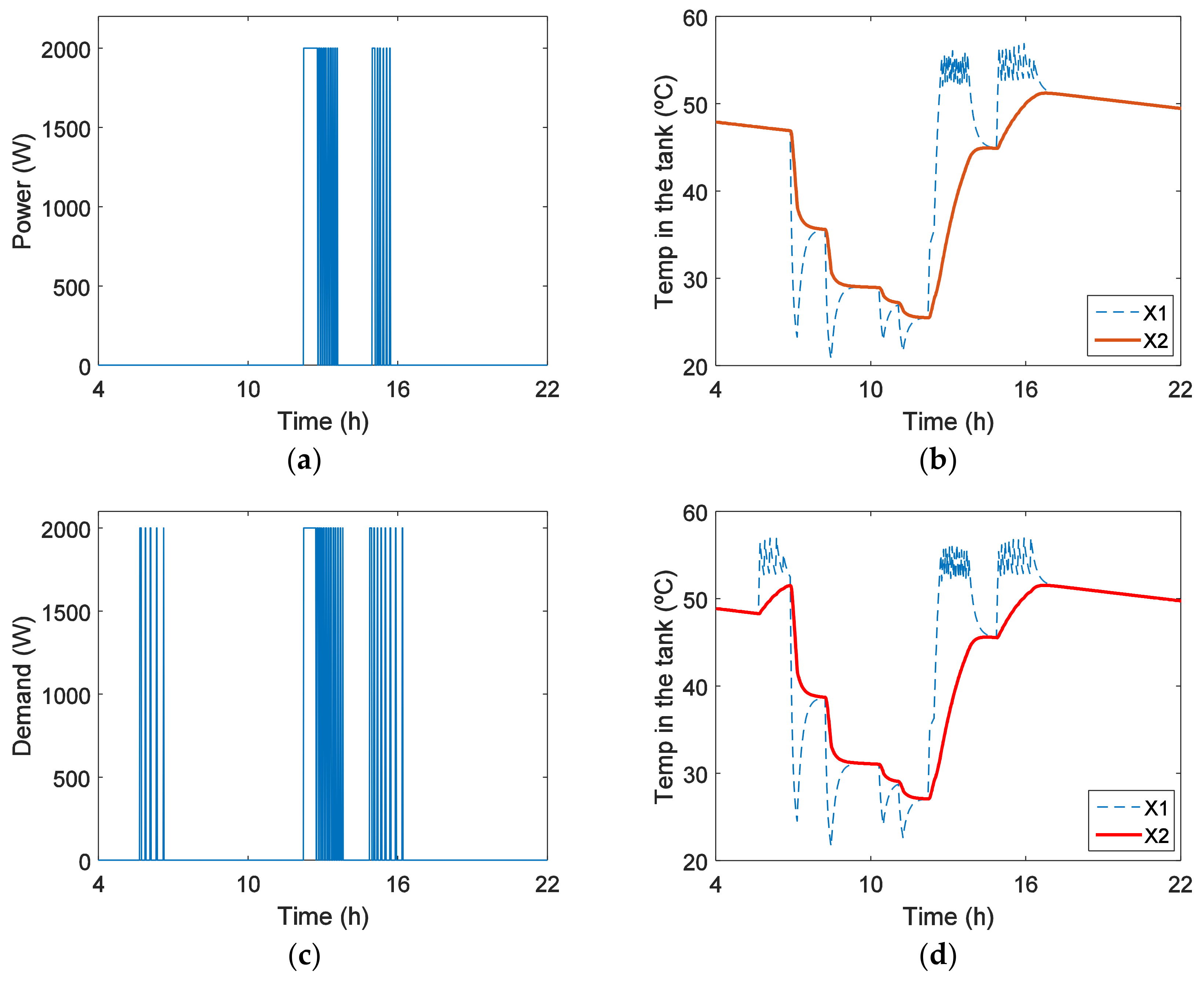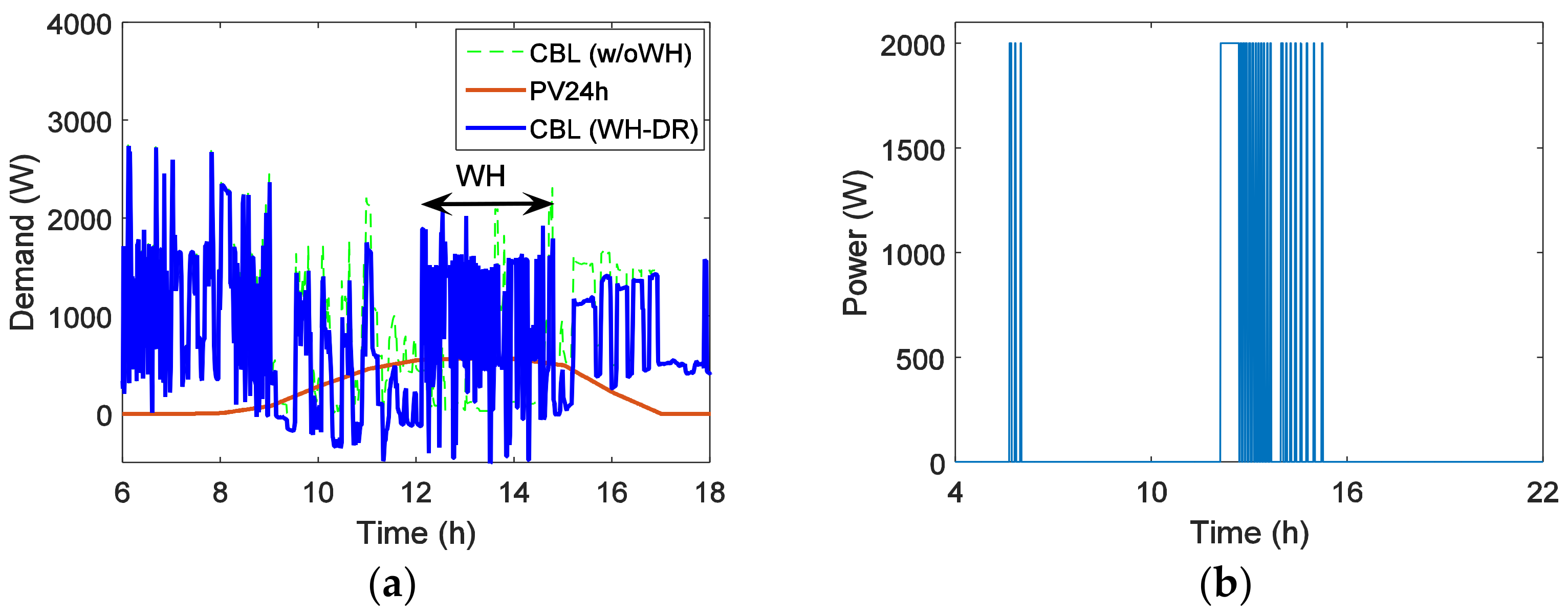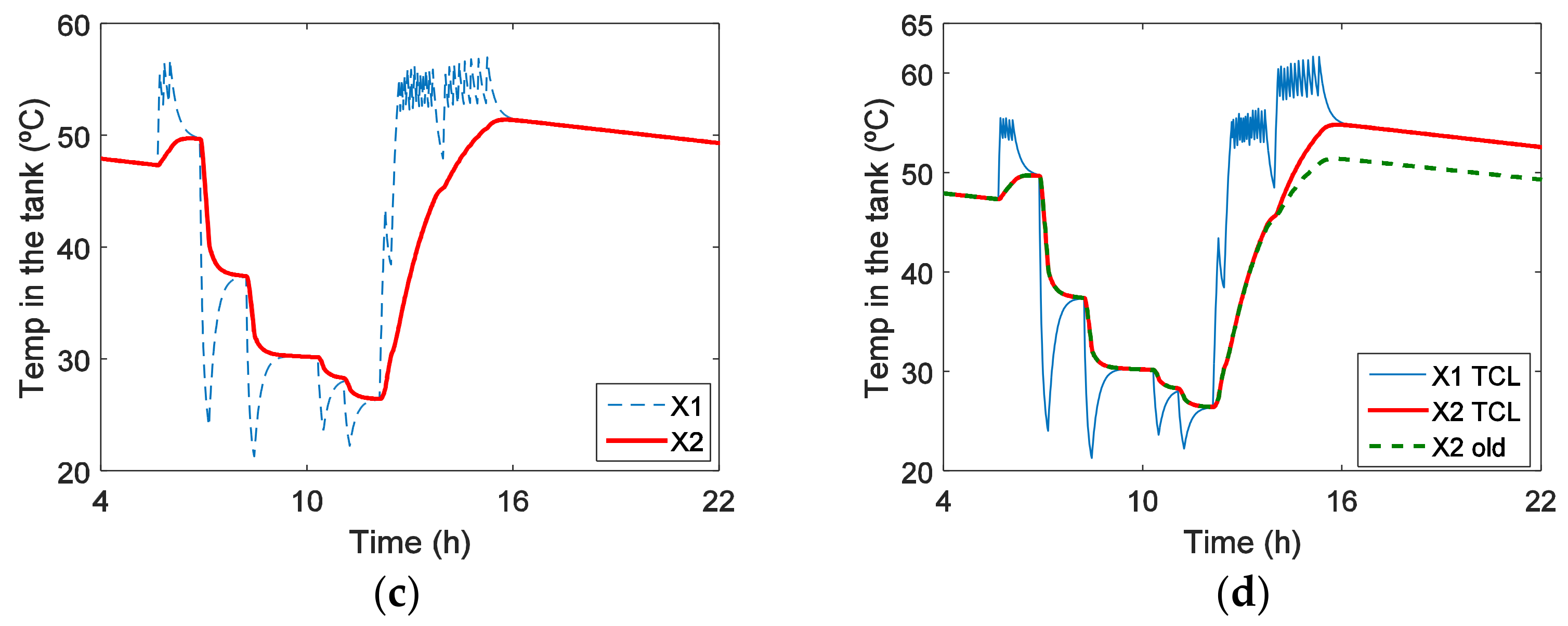2.1. Customer Description
A typical (representative) residential customer in Spain has been monitored for simulation and validation purposes (3.5 kW of rated power with an average demand of around 4 MWh/year). The overall demand (as seen by the Smart Meter) and the main end-uses have been monitored (i.e., submetering, in this case through Z-Wave devices) for two years, to accomplish the verification of load models and the evaluation of Non-Intrusive Load Monitoring methodologies. Similar data, as presented in this paper, are available in the literature and in public database (see for example REDD database [
34]).
Figure 5 shows some examples of daily load curves.
The main end-uses are presented in
Table 1 (note that some end-uses exhibit a few discrete states in demand while others have a wider range of values). To demonstrate that both the validation scenario and the residential customer are representative, typical household end-uses database in the European Union EU-28 [
13] and in the USA [
35] have been considered. According to low levels of penetration of renewable solar systems in buildings [
36] (i.e., solar heat pumps and solar water heaters), electric supply has been considered as primary source for these end-uses. Several analysis in the literature state that end-use renewable solutions are perceived of as innovative and risky, and the average customer requires higher rates of return than for more conventional systems [
36] (notice that the same concern appears for Energy Efficiency measures such as the replacement of conventional WH by Heat Pump WH).
Table 2 presents the average energy consumption in households (in some cases, the share of end-uses is considered for all types of fuels because it is more representative) in Spain, EU-28, and the USA. Notice that in European Mediterranean climate regions like in the USA southern regions, air conditioning loads represent a higher percent (66% of households have this appliance and the trend is quite solid in this decade: around 700,000 new units in Spain, 80% of them in the residential sector, i.e., 12% of the EU market [
37]). The assumption of annual residential percentages (national reports) in the proposed scenario (“prosumers”) could be a critical error for simulation purposes (i.e., DR potential being considered in summer periods, when solar resources and HVAC peak).
Figure 6 presents the overall demand and the consumption of main residential end-uses in a typical winter day (23 January 2017). During these days, the average daily demand is around 22–25 kWh. The granularity of data is fixed from 10 to 20 s for a better evaluation of end-uses and to achieve a customer database with multiple possibilities (see for example REDD database in a past paper [
34]). For example, this database has been tested for Non-Intrusive Load Monitoring Methodologies (NIALM) through Smart Meter data, for different purposes and loads (the use of NIALM for the disaggregation of main loads can be found previously [
29] and for small nonlinear loads in a past paper [
39]). This pacer, for monitoring purposes, is of considerable interest in the case of some water heaters with fast switching because demand cycling ranges from 10 to 30 s in some periods. Moreover, the continuous or discrete use of electricity, the presence of one or several states for appliances, is a matter of concern for DR, and in this way, a more precise knowledge of end-uses allows an optimal estimation of Load Models and then, a better evaluation of the possibilities of the different policies available on the Demand-Side.
Figure 7 shows the overall demand and the consumption of main end-uses in two typical summer days (12 June and 2 July 2017). For those days, daily demand is around 5–6 kWh (i.e., around 25% of winter demand). The granularity of data is fixed from 10 to 20 s again. In those days, HVAC changes its service to space cooling, and the oil-filled radiator is out of service. Note that our customer has the WH controlled by a timer to take profit of ToU tariffs, but in some cases, the customer disables the timer and control actions. This is an option to take into account for any possible DR control (see
Figure 7d). Another aspect to be considered are the loss of customer service and the losses attributable to energy storage loads when the load service (hot water) and demand (electricity to heat conversion) occur with different time lags. This topic is not considered in lots of papers in the literature, mainly interested in optimization concerns of “static” loads which change demand irrespective of service or environmental variables which strongly condition demand, for instance in a past paper [
30].
Some additional data of interest from
Figure 6 and
Figure 7 are shown in
Table 3. A brief comparison between
Table 2 and
Table 3 shows that loads with storage (implicit or explicit one) such as Space Heating (up to 69% in winter), Air Conditioning (29% in summer periods), and Water Heater (from 7 to 20%) are also the main DR end-uses for the proposed “representative” customer in this study. Moreover, it is interesting to note that refrigerators are of interest too for DR (mainly in summer periods and for Ancillary Services) but its controllability is much more difficult for energy management concerns.
2.2. Solar Resource
In order to know if a location is appropriate to install solar PV systems it is necessary to take into account irradiation levels and other parameters such as modules’ orientation and inclination which influence the systems efficiency.
There are many tools available to estimate solar PV production. In this way, potential prosumers can know what benefits are going to obtain and what environmental impact is foreseen before making a decision about whether or not invest in RES. In the current study, four software packages have been analyzed: PVGIS, RetScreen, HOMER, and SAM.
First, the Photovoltaic Geographical Information System (PVGIS) has been considered [
6]. PVGIS is a research, demonstration, and policy-support instrument for solar energy resource, part of the SOLAREC action at the Joint Research Centre of the European Commission. This tool has a large meteorological and solar radiation database accessible to any user.
In order to perform simulations, the latitude and longitude of PV system location and also modules’ material, their orientation and inclination and the availability of tracking structures and ESS are required. Results obtained with this simulator perform a preliminary analysis of solar PV production.
RETScreen [
40] is a free software package developed by Natural Resources Canada National Laboratory. RETScreen can make project feasibility analysis and energy efficiency studies from renewable resources and cogeneration as well as ongoing energy performance analysis. The software calculates monthly energy production and exposes the results of an economic, technical, and environmental analysis.
RETScreen cannot make simulations with hourly consumption and only performs a prefeasibility analysis.
HOMER (Hybrid Optimization Model for Multiple Energy Resources) [
41] is a software platform that was purchased and enhanced by HOMER Energy. This tool simulates renewable systems operation and optimizes plants design. In addition, HOMER allows including in the same project renewable and nonrenewable energy systems as well as ESS, taking part of micro grids that are studied.
HOMER simulations use meteorological and consumption data from a whole year that can be entered in time intervals between an hour and a minute. Technical and economical results have much more accuracy than RETScreen because of using hourly data instead of monthly averages.
Finally, System Advisor Model (SAM) platform [
42] was selected to develop this study. SAM was created by NREL just like HOMER and it is continuously updated by its developers. SAM is a free tool that allows studying RES performance and economic feasibility.
The platform uses a large meteorological database and also a technical database about modules, inverters, and batteries which is available, including systems elements and installation costs. SAM includes links to Utility Rates Database (URDB) from NREL [
43] and Database of State Incentives for Renewables & Efficiency (DSIRE) from NC Clean Energy Technology Center [
44]. It is also possible to enter your own parameters to perform simulations.
This application uses meteorological and consumption data from a whole year, entering data in time intervals that range from a minute to an hour, the same as HOMER.
The procedure to perform simulations starts by selecting what RES is going to be studied (PV, wind, biomass, geothermal, etc.). Then, a financial model is selected. Available financial models are residential, commercial, third party ownership, and different types of Power Purchase Agreement (PPA).
Once renewable source and financial model have been selected, it is necessary to introduce technical and financial parameters from RES installation, loads (i.e., specifications from modules, inverters, batteries and their configuration, system losses including shading and snow losses, and system costs), financial parameters, and incentives, and finally information about the consumer’s electricity rate and electricity load. Finally, it is possible to make a sensitivity analysis with the main parameters of the renewable system.
2.3. Analysis of Load Flexibility through Physically Based Load Modeling (PBLM)
The flexibility of loads is a main concern to boost the generation from renewable sources on the Demand-Side, specifically for solar resources. The possibilities, for different loads and appliances, to change their consumption patterns to balance intermittent generation have been presented and discussed in previous works in the literature [
45]. Another alternative is the use of the sun as a primary energy source for end-uses [
36], but this is a complex scenario in the short term. The capability of loads to respond to DR policies depends on load behavior (and its environment) and on the possibility of loads to store energy (service provided). These facts explain that thermostatically controlled loads (TCL) are the most suitable loads for lots of DR policies (i.e., HVAC or WH). An interesting way to evaluate this response is through PBLM, a methodology first proposed by Ihara and Schweppe to solve the so called “cold load pickup” problem [
46]. The proposed approach in this section follows the same idea proposed in thermal design software tools such as eQuest and EnergyPlus [
47,
48]: a white-box model. These approaches sometimes are too complex to evaluate load response in the short term (e.g., EnergyPlus works with high order state-space models, e.g., the model order is approximately 30–40) and they need some simplification to make costs affordable and efforts feasible to engage DR. Some software, for example the toolbox BRCM, is proposed to reduce and simplify the higher order of EnergyPlus models [
49] while the toolbox uses the same physical information as the input database (another advantage of white-box approaches) [
50].
The advantage of “white box” models as PBLM (or “grey box” according to some authors [
51]) is that they allow the user to evaluate the effects of a nonelectrical input/parameter/variable (e.g., the effects of roof and floor insulation, solar radiation levels or the customer service, the changes on water flow q(t) at some established temperature…) to estimate demand changes and energy savings, which is necessary in the case of the implementation of DR policies, or in balancing the volatility of RES (understood as a lack of predictability of the series and not as a time series with a high variance [
52]).
Since DR is complex for the demand-side actors (customers and energy aggregators), the philosophy adopted for modeling is to save time, information, and resources and, consequently, use the same modeling basis for different DR policies, markets (Energy, Capacity or Ancillary Services), and loads, whenever possible [
53]. This seems affordable with the use of PBLM models because they involve physical information of loads, appliances, and environment. Moreover, the aggregation and validation of these individual models is performed through several tools [
29,
54].
Figure 8 presents the basic steps to build a PBLM model. First, the researcher should find the energy flows on the load (appliance and its environment) and the physical laws that govern these heat flows. For the case of WH, the load needs to supply thermal energy (
HR(
t) converted from mains electrical supply, R) to the inlet water flow
q(
t) (litre per minute) to raise the temperature of the water in the pipeline
Xp(
t) to the service temperature
XS(
t) desired by user inside the water heater (note that due to service conditions, the temperature of water inside WH,
X2(
t), may or may not reach
XS(
t)). As the temperature of the water increases (water gains energy, at a rate explained by its specific heat
ce and the mass of water stored in the WH,
mw, i.e., usually done in liters or gallons), the load faces losses through the external envelope and the pipelines (
h, thermal transmission coefficients or U values) that cross outside the WH tank. The energy balance Equation (hot water energy service equals net energy inputs minus losses) can be expressed by:
These equations are translated to a thermal-electric equivalent to make more homogeneous the further and necessary aggregation of individual models, for instance, to achieve a minimum level of load to participate in energy markets [
55,
56]. These PBLM models usually have several components (sub-models), for example:
- -
Load/environment: parameters that represent heat losses/gains (conduction/convection through the external envelope: GE1, GE2; the pipeline: GC1 and GC2). Also, the model takes into account heat storage from the specific heat of water (C1 and C2).
- -
The appliance: and its energy conversion into hot water. This is represented by a current source (HR) and is independent of the kind of WH (standard or Heat Pump Water Heater, HPWH).
- -
Control mechanisms (one or several) which drives the demand: a thermostat in some loads, i.e.,
m(
t) in
Figure 8b.
- -
The state variables that usually are temperatures: the temperature of the water inside the virtual subtanks WH-1 and WH-2 (X
1) and (X
2), as shown in
Figure 8b. In this case two tanks have been considered to account for the stratification phenomenon in the tank [
57].
- -
The service of the load: the water load flow q(t) at a certain temperature level Xs.
These parameters must be evaluated through measurements, the application of physical concepts, inspection on-site, and data from the manufacturer. Comparison of the pre and post calibration model shows that a calibration process in white-box models greatly improves the model’s accuracy for each en use [
48,
58]. For example, the initial estimation of the capacitance value in the equivalent heat storage (
C1 or
C2) can be evaluated by:
where:
V is the volume of the WH tank,
ρ is the water density (from 0.998 at 20 °C to 0.983 at 55 °C) and specific heat
ce of water.
PR is the power of resistor (in average) and
COP is the coefficient of performance (this is an important factor for WH Heat Pumps).
For instance, state-space representation for the model presented in
Figure 8a,b and Equation (1) is:
where
D is the differential operator and, coefficients, state variables, and inputs have been previously described (the nomenclature section is at the end of this paper).
The resolution of state-space system (3) allows the evaluation of thermal losses. This is an important value for the change of WH patterns (as shown in
Section 3). For example, system losses through the tank envelope (and WH class, i.e., its energy label) can be evaluated in a period of time
T through:
Some other values can be extracted from (3), for example the State of Charge (
SoC), the capacity of thermal storage (TESScap), or the Reserve Margin for Storage (
RMS, per unit) to store additional energy from operational conditions (i.e., rise the service from
X1,
XS to the maximum thermostat set-point
XSMAX), specifically:
These models (3)–(5) have been implemented in Matlab, validated, and the parameters have been calibrated through several measurements in individual customers: for example, a start-up test (for the evaluation of the stratification of water inside the tank and definition the size of subtanks, see
Figure 8a) with the tank in a certain state of charge (
SoC, i.e., hot water temperature at the beginning of the test), standby-tests and some tests with several service levels, i.e., different water draws
q(
t). Another approach to identify the entries of matrices in Equation (3) of PBLM models is to develop a regression problem [
50], i.e., a nonlinear optimization problem that involves multiplication of the variables (the model parameters). Authors observed in a past paper [
50] that if the dataset is small, the regression problem can lead to an unstable bilinear model. This can be overcome by the evaluation of initial values in (3) from a physical evaluation of the thermal processes in the load and its environment.
Figure 9 shows the standby times of the test appliance and its model. Appliance switching times between ON periods are around 50–55 min and show an small difference with the model but, in this case, the energy consumption during the start-up and the standby modes is more important for calibration [
48] and validation purposes (an average demand around 30 Wh/h in standby for the model and from 27 to 33 Wh/h in the real tests, time periods from 6 h to 10 h are shown in
Figure 9a. The consumption during charge (from 0 to 4 h) is 1.65 kWh in the real test, and 1.52 kWh for the simulation model, i.e., around 8% of error, mainly attributable to the stratification of water inside the tank and the accuracy of the control mechanism, i.e., the thermostat,
m(
t)).
2.5. Economic Analysis
For this study, two benchmarking tools have been considered to evaluate the cost-effectiveness of the project: Payback time and Levelized Cost of Electricity.
Payback time is a simple method to study the adequacy of the investment and represents the number of years before the system begins to generate some profit.
Levelized Cost of Electricity (
LCOE) is a financial parameter used to assess feasibility and cost-effectiveness of different generation sources on a consistent basis [
42]. Usually, it is used to compare renewable energy generation with traditional technologies.
LCOE is calculated as the sum of the total lifetime cost of producing electricity with the system divided by the total estimated energy generated from the system over its lifetime. That is depicted in Equation (7):
where
C0 is the initial investment costs;
Cn are the annual project costs including operation and maintenance (O&M) expenditures in year n; d is the discount rate;
En is the energy (kWh) generated by the system in year n; and N is the investment analysis period in years.
LCOE results are expressed in price per kWh, in this case in €/kWh.
LCOE represents the total project lifecycle costs and it can be understood as the price at which total energy generated by the system must be sold to make it profitable during its lifetime.
2.6. Environmental Analysis
One of the most important benefits for increasing renewable generation is the reduction of GHG emissions. Some impact indicators have been used in order to be able to measure the impact of renewable systems and their associated emissions during their life cycle, known as Life Cycle Assessment (LCA).
Life cycle of solar PV systems starts obtaining raw materials and includes all phases of manufacturing, transporting, and installing the system. Also, it is necessary to include the energy used to manage and recycle all the elements at the system end of life.
For this study, Energy Payback Time and Energy Return on Investment have been selected to analyze the life cycle environmental impact from solar PV systems.
Energy Payback Time (EPBT) is defined as the period required for a renewable energy system to generate the same amount of energy (in terms of primary energy) that was used to produce and recycle the system itself [
59].
where:
Emat: Primary energy demand to produce materials comprising PV system;
Emanuf: Primary energy demand to manufacture PV system;
Etrans: Primary energy demand to transport materials used during the life cycle;
Einst: Primary energy demand to install the system;
EEOL: Primary energy demand for end-of-life management;
Eagen: Annual electricity generation;
EO&M: Annual primary energy demand for operation and maintenance;
ηG: Grid efficiency, the average primary energy to electricity conversion efficiency at the demand side.
The sum total of the (renewable and nonrenewable) primary energy harvested from the geo-biosphere in order to supply the direct energy (e.g., fuels and electricity) and material (e.g., Si, metals, and glass) inputs used in all its life-cycle stages is known as the life-cycle cumulative energy demand (CED) [
59] and corresponds to the numerator of the Equation (8).
Energy Return on Investment (
EROI) is calculated by dividing system lifetime period between EPBT.
EROI can be calculated using the following equation:
where
T is lifetime period in years and the other parameters match those defined for EPBT.
EROI is a dimensionless ratio that indicates how much energy is obtained from a system of an energy source compared to how much of that energy is required to create and implement the system [
60].
EROI also can be understood as the amount of primary energy which is returned to society (i.e., preserved for alternative uses) per unit of primary energy invested in PV, in reference to the current grid mix [
61]. If
EROI is greater than 1, then the energy production over the PV-system lifetime is larger than the initial energy investment in the manufacturing process [
62].
For both indicators, to obtain clear results it is mandatory to choose the approach that most accurately describes the systems parameters and to specify the approach on which the calculation is based. Thus it is necessary to specify the reference electricity mix [
58].
There are two existing conceptual approaches to calculate both parameters. The first approach includes using, in the power grid mix, renewable and nonrenewable sources, and understanding PV systems as replacements of all the energy sources used in the power generation mix. The second approach only takes into account nonrenewable sources, understanding PV systems as replacements of nonrenewable energy sources used in the power grid mix.
For this study, parameters of the Spanish 2017 generation mix (electricity from renewable and nonrenewable sources) have been used as reference scenario.
For the calculations of LCA, the information obtained from Ecoinvent database has been used [
63] and adapted to specific operating conditions relating to the case of study.
